Contents
Cherry Iput has been successfully grown by gardeners in our country for a long time. This variety is bred specifically for the weather conditions of Central Our Country. It is frost-resistant and partially self-fertile, which greatly simplifies the work of caring for plantings.
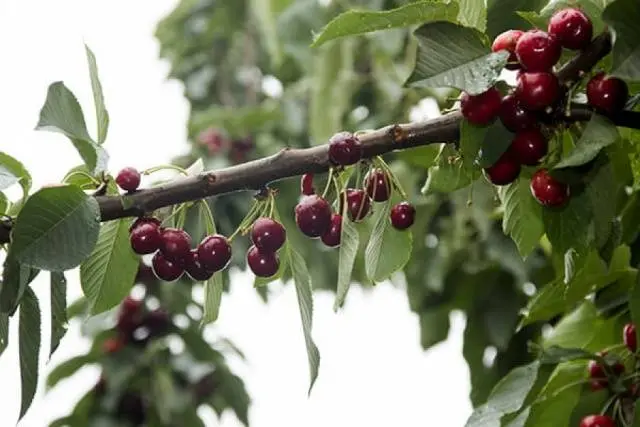
The combination of all these factors plus a good yield – all this has become the key to the successful distribution and cultivation of this sweet cherry variety.
History of breeding
The birthplace of the Iput cherry is the village of Michurinsky, Bryansk region. The All- Scientific Research Institute of Lupine, which was located here in the 80s of the last century (now it is a branch of the Federal State Budgetary Scientific Institution “V.R. Williams Federal Scientific Center for Forage Production and Agroecology”) was engaged at that time not only in the selection of fodder crops, but also by breeding new varieties of berry bushes.
More than 65 varieties of cherries, sweet cherries, black currants, raspberries and apple trees have become the result of this painstaking work. One of them is the Iput cherry variety, named after the river of the same name, which flows in the Bryansk region. Its authors are breeders Kanshina M.V. and Astakhov A.A. In 1993, the variety was included in the State Register.
Description of the culture
Cherry Iput is a medium-sized tree with a fairly wide crown. It usually begins to bear fruit from 4-5 years of age. The yield is average. This variety can be grown in many regions. Cherry Iput is considered an early variety.
Features
The main characteristics of the cherry variety Iput are given in the table.
Parameter | Value |
Culture type | fruit stone tree |
Height | On average 3,5, sometimes up to 4,5–5 m |
Bark | reddish brown |
Crown | Broad, pyramidal |
Leaves | Dark green, matte, egg-shaped. The plate is slightly curved, the surface is without pubescence. Length up to 8 cm, width up to 5 cm |
foliage | Thick |
Fruit | Large, dark red, almost black. The average weight of a berry is 5–9 gr. |
Pulp | Red, juicy |
Taste | Sweet, slightly bitter aftertaste |
Bone | Small, difficult to separate |
Variety assignment | Universal |
Transportability | Medium, weak in fruits with cracking |
Drought resistance, winter resistance
Winter hardiness is one of the advantages of the Iput cherry variety. Quite calmly, the trees will endure frosts down to -30 ° С. Thaws are more detrimental to cherries, followed by a sharp cold snap. After positive temperatures, frost even down to -20 ° C is almost guaranteed to kill a tree.
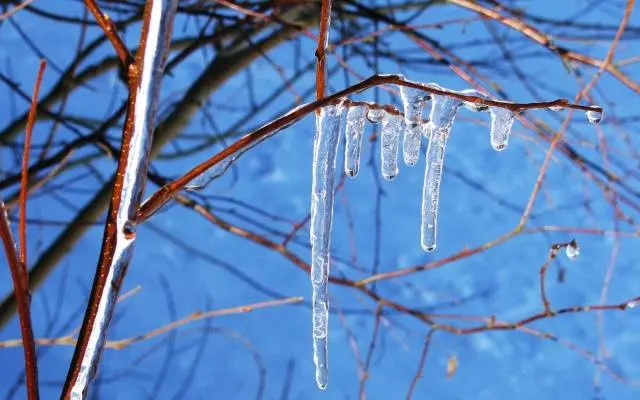
The drought resistance of the Iput sweet cherry variety is good. Even with a severe drought, it is recommended to water it no more than 1 time per week. Excess moisture affects primarily the berries, which begin to crack.
Pollination, flowering period and ripening period
Cherry blossom time Iput depends on the region of growth. In the middle lane, this is the middle of May, in the more southern regions, the dates are earlier. The tree blooms very beautifully, in dense white clusters.
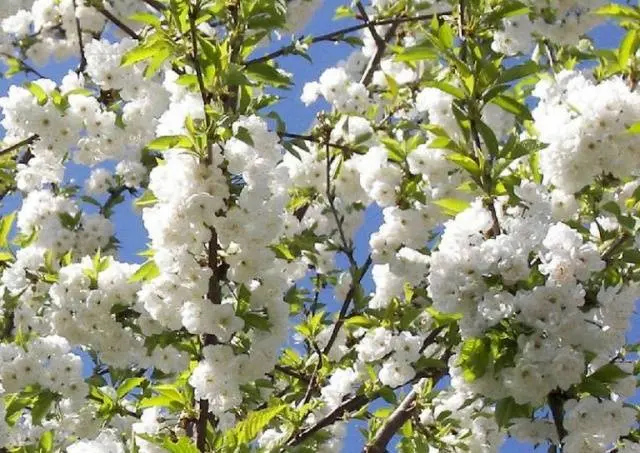
The Iput cherry variety is considered partially self-fertile, that is, self-pollinating. However, in reality, the percentage of self-pollinated flowers is quite small (as a rule, no more than 5–7% self-pollinate). Therefore, to obtain a good harvest, it is necessary to plant nearby plants – pollinators. For Iput cherries, the Revna, Tyutchevka or Ovstuzhenka varieties are suitable in this capacity. Berries fully ripen by the end of June.
yield, fruiting
Starting from the fifth year of life (less often from the fourth), the fruiting of the Iput cherry tree becomes regular. The harvest on it ripens every year and averages 30 kg per tree. However, with proper care and compliance with all the rules of agricultural technology, the yield can be doubled.
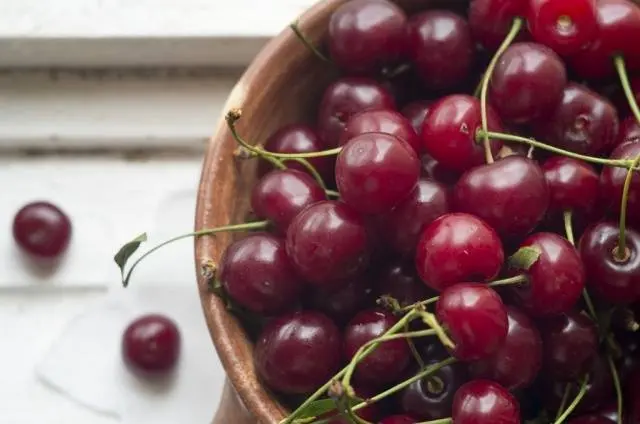
Scope of berries
The versatility of the Iput cherry variety allows the use of fruits both fresh and processed. It makes excellent compotes, jams, jams. Among all varieties of sweet cherry, Iput has the highest content of vitamin C, so its berries are not only tasty, but also very healthy.
Disease and pest resistance
Cherry Iput has good immunity to pests and diseases. Most often, trees suffer from fungal diseases in conditions of high humidity or with improper pruning. Of the pests, aphids are the most dangerous.
Advantages and disadvantages
There are quite a few advantages of Iput cherries. Here are the main ones:
- frost resistance;
- stable annual yield;
- early ripening;
- resistance to diseases and pests;
- the tree is not very tall, it is convenient to pick berries;
- the variety is universal in purpose;
- good taste of berries (tasting score 4,4 out of 5).
The disadvantages of the variety include the following:
- late entry into fruiting (4-5 years);
- the tendency of fruits to crack with excess moisture;
- poor separation of the bone from the pulp.
Features of landing
When planting Iput cherries on a personal plot, you should immediately take care of pollinators, otherwise you may not wait for the harvest. Saplings are almost always planted in a group (an exception can be made if cherries also grow near the fence of the neighbors).

In addition, there are several other factors to consider.
Recommended dates
The timing of planting Iput cherry seedlings is highly dependent on the region. In the south, in climatic zones with mild winters, this can be done both in spring and autumn. Moreover, autumn planting is considered more preferable, since a tree planted in spring will constantly suffer from lack of water and sunburn. In more northern territories, autumn planting is completely excluded. The seedling simply does not have time to take root and will die.
A prerequisite for planting Iput cherries is that the seedlings must be at rest. In the spring, this is the time before the juices begin to move and the buds swell, and in the fall – after the leaves fall.
Choosing the right place
For good growth and high yields, the place for growing Iput sweet cherries must meet the following conditions:
- There should be no other trees between the planted seedlings so as not to interfere with cross-pollination.
- The place should be sunny and protected from the cold wind.
- The soil should be light, fertile, sandy or loamy, with neutral acidity.
- Ground water should not be higher than 2 m.
- The landing site should not be located in a lowland or any other place where stagnant water is possible.
What crops can and cannot be planted next to cherries
Cherry Iput is not a pronounced aggressive plant like, for example, walnut. However, you should not plant an apple, pear or plum tree next to it. It is better when another cherry grows nearby (which is useful for pollination) or cherry. It grows well next to the sweet cherry grapes. Often a black elderberry is planted nearby, it remarkably protects plantings from aphids.
Flowers grow surprisingly well under the Iput cherry: daffodils, tulips, primrose. But it is better to refuse planting tomatoes or potatoes in the root zone.
Selection and preparation of planting material
For planting Iput cherries, it is better to use two-year-old seedlings. By this time, the tree should have the following parameters (in the table).
Parameter | Value |
Barrel diameter, mm | At least 15 |
Number of branches, pcs | At least 3 |
Branch length, m | At least 0,3 |
Root system | Well developed. The root on the cut is clean, without rot, the color of the cut is cream |
Bark | Clean, smooth, without damage and neoplasms |
You should pay attention to the difference in the thickness of the rootstock and scion. It is clearly visible on grafted seedlings.
Landing algorithm
Iput cherry seedlings are planted at a distance of at least 3 m from each other. Landing pits must be prepared in advance, for example, for spring planting they are prepared in the fall. The size of the pit should be 1 m by 1 m and a depth of at least 0,8 m. The excavated soil must be saved, and a nutrient substrate will subsequently be made from it. To do this, it is mixed with 3 buckets of humus and 0,25 kg of superphosphate is added.
Before planting, the seedling is inspected again, if necessary, cut off the damaged roots. Slightly away from the center of the pit, a stake is driven in, which will serve as a support for the young tree at first. A mound of soil is poured at the bottom of the pit, on which the seedling is installed in such a way that its root collar is at ground level. After that, the roots are gradually covered with nutrient soil, compacting it to prevent the formation of voids.

An earthen rampart is poured around the seedling, which will prevent the spread of water. The planted tree is tied to a support and watered with 3-4 buckets of water. Then the trunk circle must be mulched with straw or sawdust.
Culture aftercare
To have a good harvest, you need to properly form the crown of the future tree. For this, formative pruning is used, making the crown of the tree multi-tiered.
- The first pruning is done in the second spring after the habit. At this time, the first tier of 3-4 main branches is formed, located at a distance of 0,5–0,6 m from the ground. All other shoots are cut in half or cut out completely.
- The next spring lay the second tier, leaving 2 branches at a distance of 0,5 m from the first. The rest are cut out.
- The following year, 1 branch is left above the second tier, and the main trunk is cut off.
- In the following years, all annual shoots are shortened by half.

In addition to forming, every year you need to carry out sanitary pruning, cutting out diseased, dried or broken branches. In addition, shoots that grow incorrectly and thicken the crown are cut off.
Cherry Iput is a moisture-loving crop, but excess water is detrimental to it. Therefore, watering is necessary only during dry periods.
Iput cherries are fertilized throughout the season. In the spring, fertilizers are applied three times:
- Before the tree blooms, ammonium nitrate 20 g per 1 sq. m.
- During the flowering period, a urea solution of 20 g per 10 liters of water is added.
- At the end of flowering, chicken manure is introduced into the root zone in the form of a solution at the rate of 1,5–2 liters of concentrate per bucket of water.
In the summer, foliar top dressing of Iput cherries is carried out with potassium monophosphate or nitrophoska. In autumn, organic matter is used, introducing humus into the near-trunk circle.
Cherry Iput does not require shelter for the winter. However, some caring gardeners in cool climates cover young trees using special covering materials.
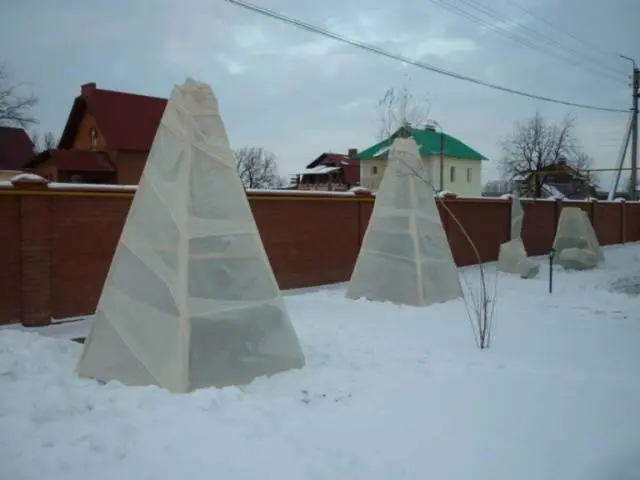
The stems of mature Iput cherry trees should be whitewashed to prevent sunburn and damage by pests wintering in the folds of the tree bark.
Diseases and pests, methods of control and prevention
Sweet cherry Iput gets sick relatively rarely. Most often, diseases appear from excessive moisture or poor tree care. The main diseases of sweet cherry are shown in the table.
Disease | Signs of appearance, consequences | Prevention of occurrence and treatment |
Rust | Brown spots on leaves. Affected leaves die and fall off. | Treatment with Hom before flowering. After harvesting, re-treatment with Bordeaux liquid 1%. Affected shoots must be cut and burned. |
Klesterosporiosis (perforated spotting) | Brown spots on the leaves, holes are subsequently formed at the places of their appearance. The shape of the fruit changes. | Three times per season (before flowering, after it and after 2 weeks) treatment of plants with a solution of copper-containing preparations or Bordeaux liquid 1%. Affected leaves should be cut off and burned. |
Kokkomikoz | Purple spots on the leaves, which soon dry up and fall off. | After flowering and after picking berries, it is necessary to treat with Bordeaux liquid 1% or copper oxychloride. |
Of the pests, the cherry weevil and cherry aphid are the most dangerous for Iput cherries. They fight them with the help of various insecticides (Decis, B-58) or folk remedies (soap solutions, infusions of tobacco, celandine, wormwood).
Conclusion
Cherry Iput has long and deservedly taken its place among horticultural crops in many regions of the country. However, most gardeners agree that he lacks a certain zest for which it is worth holding on to. However, how many people, so many opinions. Therefore, the gardener himself will decide whether to plant or not plant this variety or replace it with another. And cherry Iput is definitely a good choice.









